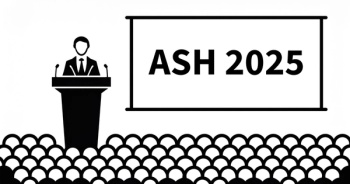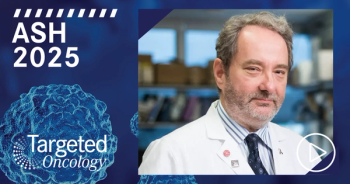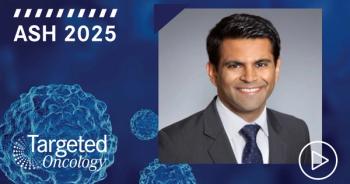
Current Status and Future Directions in RRMM
Sagar Lonial, MD, FACP, discusses the management of heavily pretreated relapsed/refractory multiple myeloma and its future.
Sagar Lonial, MD, FACP: When we think about patients in the refractory myeloma setting, it’s clear that new drugs have made a big difference. If we look at expected overall survival from patients in the DREAMM-2 study [NCT03525678], it’s well over 1 year. When we started this conversation, I told you that the anticipated survival of a triple-class refractory patient with a median of 6 prior lines of therapy was less than 1 year. These new treatments are already beginning to have an impact in terms of progression-free and overall survival. As with every other drug in the context of myeloma, our goal is to combine them with other drugs that are out there, and we’ve seen that in the context of belamaf being combined with pomalidomide, for instance, in the ALGONQUIN study [NCT03715478] and with bortezomib in the DREAMM-6 clinical trial [NCT03544281]. There are other studies on the horizon, combining it with combinations such as VRd [lenalidomide, bortezomib, and dexamethasone] or other potential agents or combinations in this setting. Figuring out the right dose and schedule will be important and give us additional treatment options. If we’ve learned anything [about] myeloma in the past 2 decades, it’s that combination therapy ends up being the answer because it’s not 1 plus 1 equals 2. It’s 1 plus 1 equals 4 or 5, and that is the goal of combination therapy. When we think about other drugs that are promising in terms of late-stage clinical development that have an opportunity to potentially improve or extend overall survival, the classes of agents that we’re excited about are CAR T cells, which can target BCMA [B-cell maturation antigen] right now. CAR T cells look exciting in the context of refractory myeloma, with high overall response rates and median durations of response right now of [approximately] 1 year. More importantly, the incidence of cytokine release syndrome and neurologic toxicity appears to be lower in patients [with myeloma] who received CAR T cells [as opposed to] CAR T cells [given to patients with] lymphoma or acute lymphoblastic leukemia. Those are exciting concepts, as well. Additionally, the use of bispecifics, or BiTE, targeting either BCMA or GPRC5D for FCRH5 also look exciting, and when we get to mix in antibody drug conjugate, a bispecific, and a CAR T cell—all targeting BCMA because loss of BCMA is not the major mechanism of drug resistance in myeloma—we may be able to sequence these therapies in ways that patients can get the benefit of not just 1 drug in this class but 2 or even 3 drugs to potentially maximize the response duration and mechanism of action. For patients across the board, the future looks bright, with many new treatments coming in the context of refractory myeloma. We look forward to bringing those earlier and earlier in the disease course and hopefully increasing the fraction of patients we ultimately cure.
One of the key pieces of advice that I often offer to patients, as well as community oncologists when they’re treating patients with [challenging cases of] myeloma, is to partner early with an academic center that has access to many of these clinical or clinical trial options. The field, treatment scope, and treatment approach in myeloma are changing so fast that it’s hard to keep up. I don’t think any of us in the academic community want to take patients away from anybody. We would prefer patients to be treated closer to home and use their local community and doctors, but there may be situations or settings where that’s not possible because you’ve gone through all the available agents and patients need access to trials. The optimal time to refer for a trial is not when the counts are terrible, in extremis, and there aren’t many options left. It’s in the early relapse or earlier relapse setting, so that we can get to know the patient, they can understand what the potential treatment options are, and we can establish that relationship to allow them to get access to trials when they need them. It’s about getting as much treatment closer to home as possible, as well, so that partnership earlier in the patient’s disease is critical to maximizing the potential benefit patients may get from these new drugs.
Transcript edited for clarity.
A 72-Year-Old Man with Heavily Pretreated, R/R Multiple Myeloma
Initial Presentation
- A 72-year-old man diagnosed with multiple myeloma 4.5 years ago returns for routine follow up
- Treatment history:
- Initially treated with VRd for 12 months, followed by lenalidomide maintenance 15 mg daily; stable disease lasting 36 months
- Rechallenged with VRd, stable disease lasting 20 months
- Subsequently switched to KPd, achieved a partial response lasting 15 months
- Started DVd; follow up at 12 months showed M protein increase by 0.5 g/dl; patient continues to feel well
- Currently, 3 months after his last visit, he returns to the clinic complaining of increased muscle weakness, fatigue and bone pain
- PE: new bony tenderness appreciated on ribs, bruising, mild bleeding of the gums
Clinical Workup
- Labs: Hb 8.8 g/dL, calcium 10.2 mg/dL, LDH 160 U/L, creatinine 2.1 mg/dL, albumin 3.0 g/dL, b2 microgloblulin 4.9 mcg/mL, serum M-protein 4.2 g/dL, lambda free light chains 4.1 mg/dL
- HBV negative
- Skeletal survey and MRI revealed stable lytic bone lesions in the left hip, pelvis and L2 vertebrae and new lytic lesions on the ribs 4 and 10 on the left side
- Bone marrow shows 70% plasma cells IgG k
- FISH: t(6;14) (p21;q32) at diagnosis; new del(17p)
- Diagnosis: R-ISS stage II MM
- ECOG 1
Treatment
- Initiated treatment with belantamab mafodotin









































